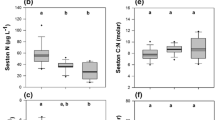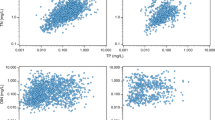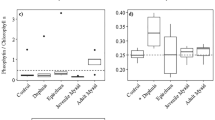Abstract
Empirical models based on zooplankton biomass were used to predict mean summer chlorophyll a (Chl a) and to examine how zooplankton influenced the total phosphorus (TP) - Chl a relationship. Four years of data were analyzed for three lakes having similar TP concentrations but varied abundances of Daphnia and Ceriodaphnia. Mean TP did not correlate significantly with mean Chl a during the study period, although mean Daphnia density was a good predictor of Chl a concentration (p > 0.001). Both residuals from the TP - Chl a relationship (p > 0.001) and Secchi depth (p > 0.007) were negatively correlated with Daphnia abundance. Ceriodaphnia abundance was positively correlated with Chl a (p > 0.002) and Secchi depth (p > 0.001). Mean size of Daphnia during spring was the best predictor of the Daphnia-Ceriodaphnia shift in mid-summer. Early establishment of a large-sized Daphnia cohort may prevent their summer elimination by Chaoborus and intensify competition with Ceriodaphnia. These results imply an important link between Daphnia and Ceriodaphnia thereby limiting the utility of Chl a - TP model predictions in these small, urban lakes. This linkage and the differential effect of these two zooplankton species on planktonic algae deserve further consideration in similar lakes where phytoplankton and zooplankton tend to be tightly coupled.
Similar content being viewed by others
References
Bottrell, H. H., A. Duncan, Z. M. Gliwicz, E. Grygierek, A. Herzig, A. Hillbrictllkowska, H. Kurasawa, P. Larsson & T. Weglenska, 1976. A review of some problems in zooplankton production studies. Norw. J. Zool. 24: 419–455.
Brooks, J. L. & S. I. Dodson, 1965. Predation, body size and composition of the plankton. Science 150: 28–35.
Canfield, D. E.Jr, 1983. Prediction of chlorophyll a concentrations in Florida lakes: the importance of phosphorus and nitrogen. Wat. Res. Bull. 19: 255–262.
Carney, H. J. & J. J. Elser, 1990. Strength of zooplanktonphytoplankton coupling in relation to lake trophic state, p. 613–631. In M. M. Tilzer & C. Serruya (eds), Ecological structure and function in large lakes. Sci. Tech.
Carpenter, S. R., J. K. Kitchell & J. R. Hodgson, 1985. Cascading trophic interactions and lake productivity. Bioscience 35: 634–639.
Chow-Fraser, P. & R. Knoechel, 1985. Factors regulating in situ filtering rates of cladocera. Can. J. Fish. aquat. Sci. 42: 567–576.
Dillon, P. J. & F. H. Rigler, 1974. The phosphorus-chlorophyll relationship in lakes. Limnol. Oceanogr. 19: 767–773.
Dodson, S. I., 1974. Zooplankton competition and predation: an experimental test of the size efficiency hypothesis. Ecology 55: 605–613.
Elser, J. J. & C. R. Goldman, 1991. Zooplankton effects on phytoplankton in lakes of contrasting trophic status. Limnol. Oceanogr. 36: 64–90.
Evans, M. S. & D. W. Sell, 1985. Mesh size and collection characteristics of 50-cm diameter conical plankton nets. Hydrobiol. 122: 97–104.
Gliwicz, Z. M., 1990. Food thresholds and body size in cladocerans. Nature 343: 638–640.
Gliwicz, Z. M. & W. Lampert, 1990. Food thresholds in Daphnia species in the absence and presence of blue-green filaments. Ecology 71: 691–702.
Hoyer, M. V. & J. R. Jones, 1983. Factors affecting the relation between phosphorus and chlorophyll a in Midwestern reservoirs. Can. J. Fish. aquat. Sci. 40: 1902–1909.
Jeffrey, S. W. & G. F. Humphrey, 1975. New spectrophotometric equations for determining chlorophylls a, b, c 1 and c 2 in higher plants, algae and natural phytoplankton. Biochem. Physiol. Pflanzen. 167: 191–194.
Lynch, M., 1978, Complex interactions between natural coexploiters — Daphnia and Ceriodaphnia. Ecology 59: 552–564.
Mackay, N. A., S. R. Carpenter, P. A. Soranna and M. J. Vanni. 1990. The impact of two Chaoborus species on a zooplankton community. Can. J. Zool. 68: 981–985.
McCabe, G. & W. J. O'Brien, 1983. The effects of suspended silt on feeding and reproduction of Daphnia pulex. Am. Mid. Nat. 110: 324–337.
McQueen, D. J., J. R. Post & E. L. Mills, 1986. Trophic relationships in freshwater pelagic ecosystems. Can. J. Fish. aquat. Sci. 43: 1571–1581.
Moore, L. & K. Thorton (ed.), 1988. Lake and reservoir restoration guidance manual. North American Lake Management Society and U.S. EPA.
Nicholls, K. H. & P. J. Dillon, 1978. An evaluation of phosphorus-chlorophyll-phytoplankton relationships for lakes. Int. Revue. ges. Hydrobiol. 63: 141–154.
Noble, R. L., 1981. Management of forage Fishes in impoundments of the southern United States. Trans. am. Fish. Soc. 110: 738–750.
Pace, M. L., 1984. Zooplankton community structure, but not biomass, influences the phosphorus — chlorophyll a relationship. Can. J. Fish. aquat. Sci. 41: 1089–1096.
Pastorok, R. A. 1981. Prey vulnerabilities and size selection by Chaoborus larvae. Ecology 62: 1311–1324.
Peters, R. H., 1986. The role of prediction in limnology. Limnol. Oceanogr. 31: 1143–1159.
Prairie, Y. T., C. M. Duarte & J. Kalff, 1989. Unifying nutrient chlorophyll relationships in lakes. Can. J. Fish. aquat. Sci. 46: 1176–1182.
Rast, W., R. A. Jones & G. F. Lee, 1983. Predictive capability of U.S. OECD phosphorus loading — eutrophication response models. J. Wat. Poll. Cont. Fed. 55: 990–1003.
Ravera, O., 1980. Effects of eutrophication on zooplankton. Prog. Wat. Tech. 12: 141–159.
Redfield, G. W, 1984. Modifications to the Schindler-Patalas zooplankton trap. Verh. int. Ver. Limnol. 22: 1417–1424.
Redfield, G. W, 1991. Phosphorus, chlorophyll and the comparative limnology of three suburban lakes in Northern Virginia, U.S.A. Verh. int. Ver. Limnol. 24: 1294–1299.
Riessen, H. P., 1990, Demographic analysis of Chaoborus predation on Daphnia pulex. Verh. Int. Ver. Limnol. 24: 339–343.
Rigler, F. H., 1966. Radiobiological analysis of inorganic phosphorus in lake water. Verh. Int. Ver. Limnol. 16: 465–470.
Sarnelle, O., 1992. Nutrient enrichment and grazer effects on phytoplankton in lakes. Ecology 73: 551–560.
Schindler, D. W., 1978. Factors regulating phytoplankton production and standing crop in the worlds fresh waters. Limnol. Oceanogr. 23: 478–486.
Schwartz, S. S., 1984. Life history strategies in Daphnia: a review and predictions. Oikos 42: 114–122.
Sell, D. W. & M. S. Evans, 1982. A statistical analysis of subsampling and an evaluation of the Folsom plankton splitter. Hydrobiol. 94: 223–230.
Shapiro, J., 1990. The importance of trophic-level interactions to the abundance and species composition of algae in lakes. In J. Barica and L. Mur (eds), Hypereutrophic ecosystems. Dr W. Junk Publishers, The Hague: 105–115.
Smith, V. H., 1982. The nitrogen and phosphorus dependence of algal biomass in lakes: an empirical and theoretical analysis. Limnol. Oceanogr. 27: 1101–1112.
Smith, V. H. & J. Shapiro, 1981. Chlorophyll — phosphorus relations in individual lakes. Their importance to lake restoration strategies. Envir. Sci. Technol. 15: 444–451.
Sprules, W. G., L. B. Holtby & G. Griggs, 1981. A micro-computerbased measuring device for biological research. Can. J. Zool. 59: 1611–1614.
Taylor, B. E., 1988. Analyzing population dynamics of zooplankton. Limnol. Oceanogr. 33: 1266–1273.
Vollenweider, R. A, 1968. Scientific fundamentals of the eutrophication of lakes and flowing waters, with particular reference to nitrogen and phosphorus as factors in eutrophication. Tech. Rep. OECD Paris, DAS/CSI/68, 27, 159 pp.
Vollenweider, R. A., 1975. Input-output models with special reference to the phosphorus loading concept in limnology. Schweiz. Z. Hydrol. 37: 53–84.
Ward, J., 1955. A description of a new zooplankton counter. Microsc. Soc. 96: 371–373.
Author information
Authors and Affiliations
Rights and permissions
About this article
Cite this article
Shahady, T.D., Redfield, G.W. Relative effects of Daphnia and Ceriodaphnia on phosphorus-chlorophyll relationships in small urban lakes. Hydrobiologia 288, 47–55 (1994). https://doi.org/10.1007/BF00006805
Received:
Revised:
Accepted:
Issue Date:
DOI: https://doi.org/10.1007/BF00006805




